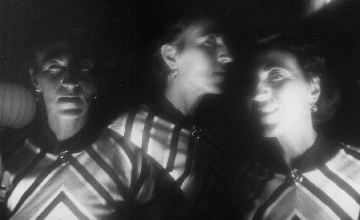 |
|
 "As in all of the collages of Helen Adam, the true desires of women are fulfilled not by mortal men, but by highly charged encounters with unhuman beings."  |
Helen Adam's Sweet Company
by Kristin Prevallet  In a dark forest, a woman in a white strapless evening gown is stiffly toppling into the arms of a gigantic tarantula. One of her arms is nestled comfortably between the spider's strong, hairy forearms, and she appears comfortable with the monstrosity that is cuddling her. In another scene two bats are attached to the sleeve of an elegant lady's gown, dangling as if a part of her ensemble. The society debutants around her appear to be oblivious to the grotesque attachment. The lady does have a slightly uncomfortable expression on her face, but it is not the bats that are making her nervous. Rather, she is worried that her private passions will be discovered by the outside world. She reassures herself, "perhaps no one will notice them." As in all of the collages of Helen Adam, the true desires of women are fulfilled not by mortal men, but by highly charged encounters with unhuman beings.  Helen Adam, whom the poet Robert Duncan once referred to as "the extraordinary nurse of enchantment" was an active participant in The San Francisco Renaissance, a literary movement contemporaneous to the Beat Generation that occurred in San Francisco during the 1950s and 60s. Born in Scotland in 1909, Adam primarily wrote supernatural ballads which tell of fatal romances, darkly sadistic sexual affairs, jealous lovers, and vengeful demons. Her collages arise from these ballads, and animate what she called her "lethal women."  She assembled the majority of her collages in the late 1950s, having been influenced by the procedures of the well-known collage artist and painter Jess who was also living in San Francisco during this time. Jess's collages are a myriad of images, fitted like pieces of a puzzle which come together to form one visionary grande-collage. Universes of tiny details and connections are assembled together, a process that reflects the palimpsistic layering of contemporary poetry as much as it does the found-object and assemblage movements that are central to modern art. When compared to Jess's collages, Adam's are strikingly simple. They combine two images-- a beautiful man or woman, and a creature. And this combination results in a ironic playfulness that teases the viewer to wonder: are these collages a form of self-portrait, a projection of this woman's deep fears mingled with her repressed desire? | ||
|
[the work] [diner] [dialogue] [theory & practice] [opportunities] [archives] Volume Two, # Two ©1999 - 2000 |